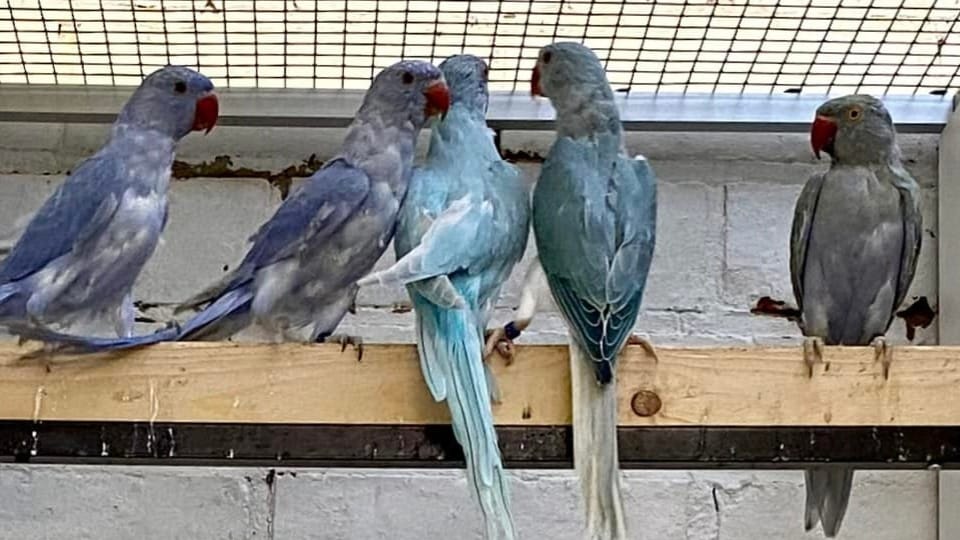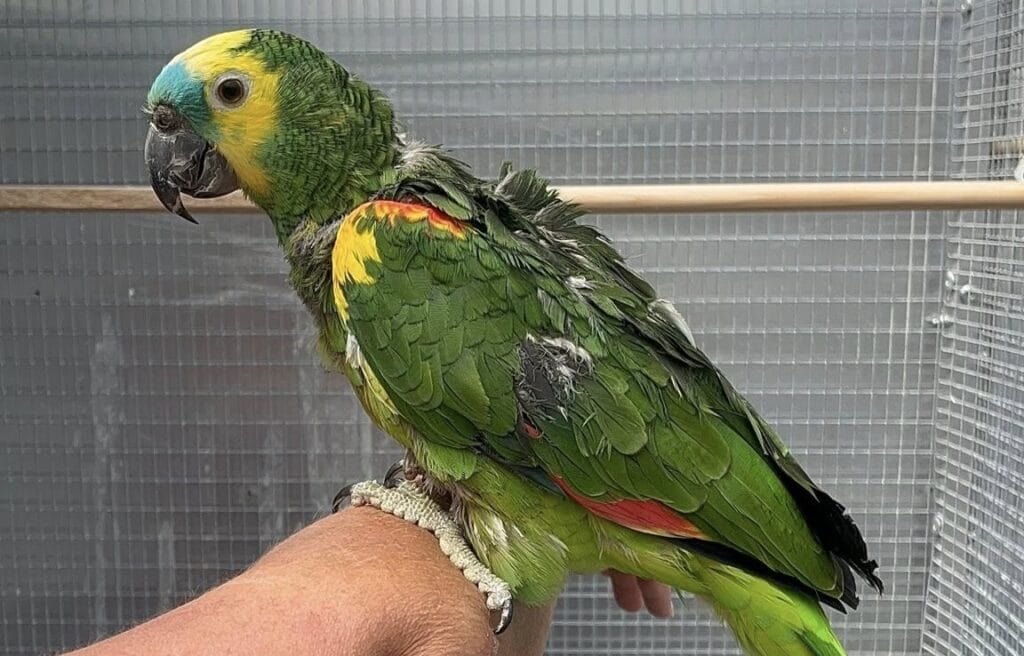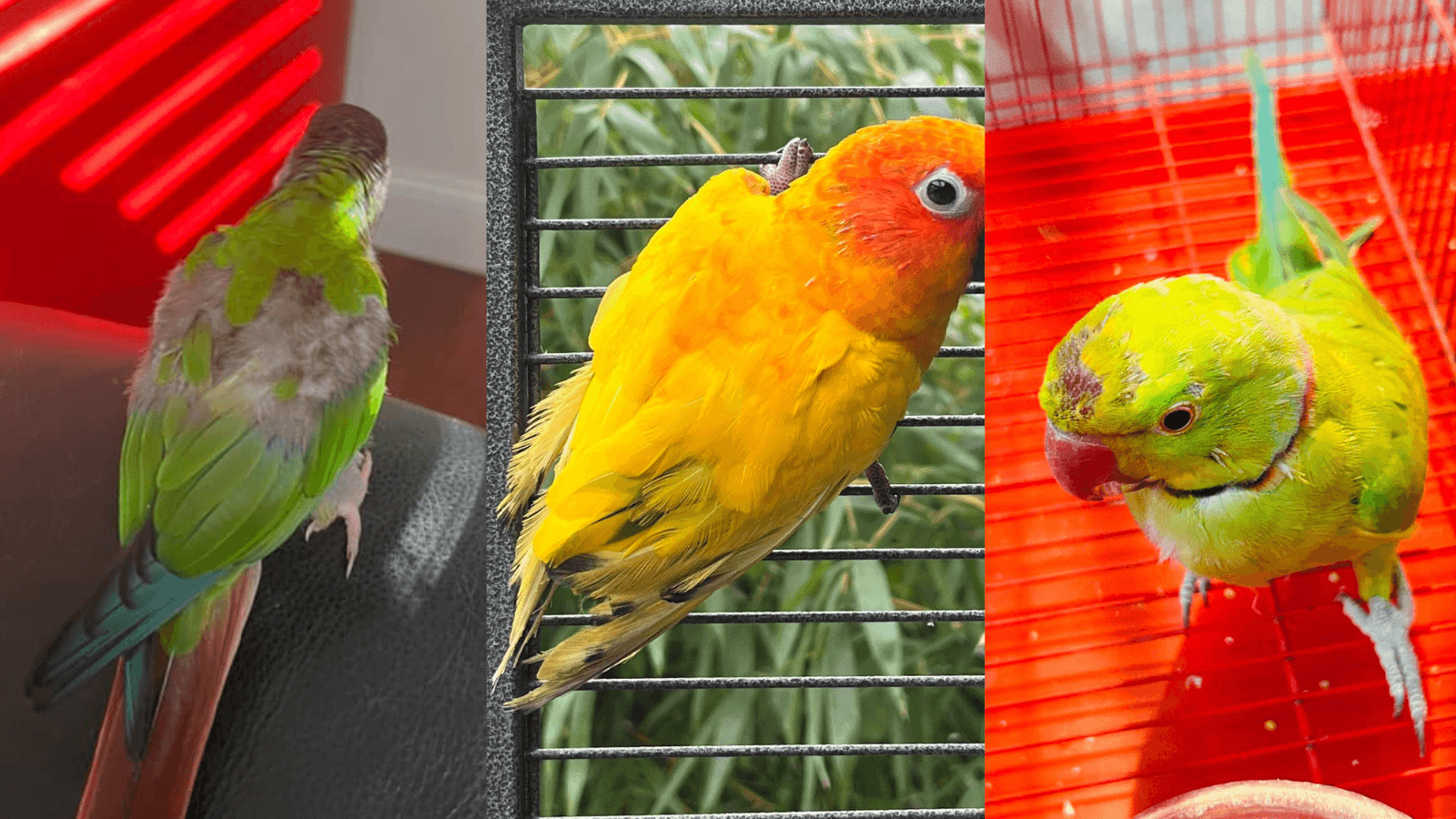Why Birds Lose Feathers – 7 Powerful Ways to Handle Molting
Understanding why birds lose feathers is crucial for any bird owner or enthusiast. Feather loss or Molting in birds is a natural phenomenon that occurs for various reasons, ranging from normal biological processes to concerning health issues. This comprehensive guide explores the primary causes behind why birds lose feathers and provides essential insights for proper avian care.
Table of Contents:
The Natural Process of Molting
What Is Molting and Why Does It Occur?
Molting represents the most common reason why birds lose feathers naturally. This essential biological process involves the systematic replacement of old, worn-out feathers with fresh, healthy plumage. During molting, birds shed their existing feathers to make room for new growth, ensuring optimal flight capabilities, insulation, and protection from environmental elements.
The molting process typically occurs once or twice annually, though timing varies significantly among different species. African Grey parrots, for instance, undergo this natural renewal process with remarkable precision, losing feathers in symmetrical patterns that maintain their flight balance throughout the transition period.
Seasonal Timing and Hormonal Influences
Why birds lose feathers during specific seasons relates directly to hormonal fluctuations and environmental cues. Light exposure, temperature changes, and breeding cycles trigger the complex hormonal cascades that initiate feather replacement. Most birds experience their primary molt during late summer or early fall, allowing sufficient time for complete feather regeneration before harsh winter conditions arrive.
The duration of molting varies considerably among species. Canaries typically require six to eight weeks to complete their annual molt, while larger parrots may extend this process over several months. Understanding these natural timelines helps bird owners distinguish between normal molting and problematic feather loss.

Stress-Related Feather Loss
Environmental Stressors and Their Impact
Environmental stress represents a significant factor in why birds lose feathers prematurely or excessively. Sudden changes in living conditions, inadequate housing, temperature fluctuations, and exposure to loud noises can trigger stress-induced feather loss. African Grey parrots demonstrate particular sensitivity to environmental disruptions, sometimes experiencing dramatic feather loss following frightening incidents during nighttime hours.
Captive birds face unique stressors that their wild counterparts rarely encounter. Confined spaces, artificial lighting, and limited social interaction contribute to chronic stress levels that manifest through abnormal feather loss patterns. These psychological pressures often result in premature molting or excessive preening behaviors that damage healthy plumage.
Psychological Factors in Feather Loss
The psychological component of why birds lose feathers extends beyond simple environmental stressors. Boredom, loneliness, and lack of mental stimulation frequently lead to neurotic behaviors, including excessive feather picking and self-mutilation. Caged birds, particularly intelligent species like parrots, may develop compulsive preening habits that escalate into destructive feather removal.
Social isolation plays a crucial role in stress-related feather loss. Birds are inherently social creatures, and prolonged separation from companions can trigger psychological distress manifesting through feather-picking behaviors. This self-destructive pattern often creates a cycle where feather damage leads to increased stress, resulting in further feather loss.
Nutritional Deficiencies and Feather Health
Essential Nutrients for Feather Development
Nutritional inadequacies significantly influence why birds lose feathers abnormally. Feather production demands substantial metabolic resources, requiring adequate supplies of amino acids, vitamins, and minerals. Protein deficiencies particularly impact feather quality, as feathers consist primarily of keratin, a protein-based structure requiring continuous nutritional support during growth phases.
Vitamin deficiencies, especially vitamins A, D, and E, directly correlate with poor feather development and premature loss. Mineral imbalances, particularly calcium, phosphorus, and zinc deficiencies, compromise feather strength and growth rates. Birds receiving inadequate nutrition often exhibit slow feather regrowth, misshapen plumage, and increased susceptibility to feather damage.
Dietary Solutions for Optimal Feather Health
Addressing nutritional factors in why birds lose feathers requires comprehensive dietary evaluation and modification. High-quality, species-appropriate diets provide the foundational nutrients necessary for healthy feather production. Supplementation with cod liver oil, as recommended for canaries during molting periods, supplies essential fatty acids that promote lustrous, resilient plumage.
Balanced commercial preparations specifically formulated for molting birds offer concentrated nutrients that support rapid, healthy feather replacement. These specialized diets typically contain elevated protein levels, essential amino acids, and targeted vitamin combinations that address the increased metabolic demands of feather regeneration.

Disease-Related Feather Loss
Viral and Bacterial Infections
Infectious diseases constitute serious medical reasons why birds lose feathers beyond normal molting patterns. Viral infections, particularly Polyomavirus and Circovirus, specifically target feather follicles, causing inflammation and disrupting normal feather development cycles. These pathogens can produce a condition known as French molting, characterized by continuous feather growth and loss without achieving complete body coverage.
Bacterial infections affecting the skin and feathers often result from poor hygiene conditions or compromised immune systems. Secondary bacterial infections frequently develop following initial viral infections, creating complex medical situations that require professional veterinary intervention. Early detection and treatment of infectious diseases significantly improve outcomes and prevent permanent feather damage.
Parasitic Infestations
External parasites represent another category of medical reasons why birds lose feathers. Mites, lice, and other ectoparasites irritate the skin and feather follicles, causing birds to scratch and preen excessively in attempts to relieve discomfort. This constant irritation leads to feather damage and loss, particularly in areas where birds can reach with their beaks or claws.
Internal parasites can also contribute to feather loss through systemic effects on bird health. Intestinal worms and other internal parasites compromise nutrient absorption, creating deficiency states that manifest through poor feather quality and abnormal molting patterns. Regular veterinary examinations and preventive treatments help maintain optimal feather health.
Hormonal Imbalances and Feather Cycles
Reproductive Hormones and Molting
Hormonal fluctuations significantly influence why birds lose feathers, particularly during breeding seasons and reproductive cycles. Elevated hormone levels trigger intensive metabolic processes that can disrupt normal feather maintenance routines. Female birds often experience increased feather loss during egg-laying periods due to calcium depletion and elevated stress hormones.
Artificial lighting conditions in captive environments can disrupt natural hormonal rhythms, leading to irregular molting patterns and unexpected feather loss. Birds evolved to respond to natural photoperiods, and artificial lighting can confuse these biological clocks, resulting in premature or delayed molting cycles.
Thyroid and Liver Function
Thyroid disorders represent significant medical factors in why birds lose feathers abnormally. Hypothyroidism commonly produces poor feather quality, delayed molting, and excessive feather loss. Liver diseases similarly impact feather health through impaired nutrient processing and toxin elimination, creating systemic conditions that compromise feather development.
Kidney dysfunction also contributes to abnormal feather loss patterns through disrupted mineral balance and waste product accumulation. These organ system disorders require comprehensive veterinary evaluation and targeted treatment protocols to restore normal feather growth cycles.
Age-Related Feather Changes
Juvenile vs. Adult Molting Patterns
Understanding why birds lose feathers requires recognizing age-specific patterns in feather development and replacement. Young birds experience unique molting characteristics, with first-year canaries replacing only contour feathers while retaining their original flight and tail feathers. This selective molting pattern differs significantly from adult birds, who undergo complete annual feather replacement.
Baby parrots commonly exhibit bent or damaged tail feathers due to their inexperience with feather maintenance and active play behaviors. Multiple tail feather breakage in juvenile birds often indicates nutritional deficiencies rather than normal wear patterns, requiring dietary adjustments to support proper development.
Senior Bird Feather Health
Aging birds may experience changes in why birds lose feathers compared to their younger counterparts. Older birds often require longer periods to complete molting cycles and may exhibit decreased feather quality due to reduced metabolic efficiency. Senior birds benefit from enhanced nutritional support and environmental modifications to accommodate their changing physiological needs.

Physical Trauma and Feather Damage
Cage-Related Injuries
Physical trauma frequently explains why birds lose feathers suddenly or in localized areas. Improper cage sizing, sharp edges, and inadequate bar spacing can cause feather damage during normal bird activities. Flight-capable birds confined to small spaces often experience wing and tail feather damage from repeated contact with cage walls and accessories.
Night frights represent a specific type of trauma particularly affecting sensitive species like African Grey parrots. These panic responses to sudden disturbances can result in complete tail feather loss and occasionally wing feather damage. The extreme nature of these incidents demonstrates how psychological trauma translates into immediate physical feather loss.
Interaction-Related Feather Damage
Social interactions between birds can explain why birds lose feathers in specific body regions. Aggressive preening by cage mates often results in feather damage to areas the affected bird cannot reach, such as the head, cheeks, and nape regions. Chewed feathers in these locations clearly indicate inter-bird aggression requiring immediate separation.
Excessive handling by humans can also contribute to feather damage, particularly during sensitive molting periods when new pin feathers are emerging. Gentle handling techniques and reduced physical interaction during molting help prevent accidental feather damage and associated stress responses.
Environmental Factors and Feather Health
Temperature and Humidity Effects
Environmental conditions significantly influence why birds lose feathers beyond normal seasonal patterns. Excessive heat exposure can trigger out-of-season molting, disrupting natural feather replacement cycles and potentially compromising bird health. Inadequate humidity levels contribute to brittle feathers that break easily and may trigger compensatory molting responses.
Proper environmental control requires maintaining species-appropriate temperature and humidity ranges throughout the year. Birds adapted to tropical climates require different environmental conditions than those from temperate regions, and failure to provide suitable conditions can result in abnormal feather loss patterns.
Lighting and Circadian Rhythms
Artificial lighting significantly impacts why birds lose feathers by disrupting natural circadian rhythms that regulate molting cycles. Continuous exposure to artificial light can suppress normal hormonal fluctuations that trigger healthy molting patterns, resulting in irregular feather replacement or retention of old, damaged feathers.
Natural light exposure provides essential cues for normal feather cycling, and birds benefit from access to unfiltered sunlight or full-spectrum artificial lighting that mimics natural photoperiods. Proper lighting management supports healthy molting patterns and optimal feather development.
Identifying Problematic Feather Loss
Normal vs. Abnormal Patterns
Distinguishing between normal and problematic reasons why birds lose feathers requires careful observation of loss patterns, timing, and associated symptoms. Normal molting produces symmetrical feather loss with corresponding regrowth, while abnormal loss often creates bald patches, asymmetrical patterns, or areas of poor regrowth quality.
Excessive feather loss that results in visible bald spots indicates underlying problems requiring veterinary attention. Similarly, slow feather regrowth, misshapen new feathers, or feathers that appear to have been plucked suggest medical or behavioral issues beyond normal molting processes.
When to Seek Veterinary Care
Professional veterinary evaluation becomes essential when observing concerning patterns in why birds lose feathers. Signs requiring immediate attention include sudden onset of massive feather loss, development of bald patches, slow or absent feather regrowth, and behavioral changes accompanying feather loss.
Early intervention often prevents minor issues from developing into serious health problems. Veterinary examination can identify underlying medical conditions, nutritional deficiencies, or environmental factors contributing to abnormal feather loss, enabling targeted treatment approaches.
Prevention and Management Strategies
Environmental Optimization
Preventing problematic reasons why birds lose feathers begins with comprehensive environmental management. Proper cage sizing, appropriate perch selection, and elimination of potential hazards reduce physical trauma risks. Temperature and humidity control systems help maintain optimal conditions for healthy feather development.
Stress reduction strategies include providing adequate social interaction, mental stimulation, and consistent daily routines. Environmental enrichment through toys, foraging opportunities, and varied perching options helps prevent boredom-induced feather picking behaviors.
Nutritional Support Programs
Implementing comprehensive nutritional programs addresses dietary factors in why birds lose feathers abnormally. Species-specific diets provide foundational nutrition, while targeted supplementation during molting periods supports increased metabolic demands. Regular dietary evaluation ensures nutritional adequacy as birds age and their requirements change.
Professional nutritional consultation helps develop customized feeding programs that address individual bird needs and health conditions. Proper nutrition forms the foundation for healthy feather development and normal molting patterns.

Supporting Birds Through Molting
Handling and Care Modifications
Understanding why birds lose feathers during molting enables appropriate care modifications during these sensitive periods. Reduced handling minimizes stress and prevents damage to emerging pin feathers, while increased environmental warmth helps birds maintain body temperature during feather replacement.
Bathing opportunities support natural preening behaviors and help remove feather sheaths from developing plumage. Shallow water dishes or gentle misting encourages birds to engage in beneficial feather maintenance activities that promote healthy development.
Monitoring and Documentation
Systematic monitoring of why birds lose feathers helps identify patterns and potential problems early. Documentation of molting timing, duration, and quality provides valuable information for veterinary consultations and enables tracking of individual bird health trends over time.
Regular photographic documentation captures feather condition and loss patterns that may not be immediately apparent to casual observation. This visual record assists in identifying subtle changes that could indicate developing health issues.
Conclusion
Understanding why birds lose feathers empowers bird owners to provide optimal care and recognize when professional intervention becomes necessary. The seven primary reasons explored in this comprehensive guide—natural molting, stress-related factors, nutritional deficiencies, disease processes, hormonal imbalances, age-related changes, and physical trauma—encompass the vast majority of feather loss scenarios encountered in both captive and wild birds.
Recognizing that feather loss represents a normal biological process in most cases helps alleviate unnecessary concern while maintaining appropriate vigilance for problematic patterns. The key lies in distinguishing between natural molting cycles and abnormal feather loss that signals underlying health issues or environmental problems requiring immediate attention.
Proactive care approaches focusing on optimal nutrition, stress reduction, environmental management, and regular health monitoring significantly reduce the likelihood of problematic feather loss. When concerning symptoms do arise, early veterinary intervention often prevents minor issues from escalating into serious health complications that could permanently affect feather quality and bird wellbeing.
By implementing the prevention strategies and management techniques outlined in this guide, bird owners can support their feathered companions through natural molting cycles while maintaining vigilance for signs that indicate why birds lose feathers abnormally. Remember that healthy feathers reflect overall bird health, making feather condition an excellent indicator of proper care and environmental suitability.
The journey of understanding why birds lose feathers continues as avian medicine advances and our knowledge of bird physiology expands. Staying informed about current research and maintaining open communication with qualified avian veterinarians ensures the best possible outcomes for birds experiencing feather loss, whether natural or pathological in origin.
FAQ
How often do birds naturally lose feathers?
Most birds undergo natural molting once or twice per year, typically during late summer or early fall. The complete process usually takes 6-8 weeks for smaller birds and up to several months for larger species.
When should I be concerned about my bird losing feathers?
Seek veterinary care if you notice bald patches, asymmetrical feather loss, slow regrowth, misshapen new feathers, or sudden massive feather loss outside of normal molting periods.
Can stress really cause birds to lose feathers?
Yes, stress is a significant factor in feather loss. Environmental changes, loud noises, loneliness, and inadequate housing can trigger stress-induced feather picking and premature molting.
What nutrients are most important for healthy feather growth?
Protein, amino acids, vitamins A, D, and E, plus minerals like calcium, phosphorus, and zinc are essential for healthy feather development. A balanced, species-appropriate diet typically provides these nutrients.

